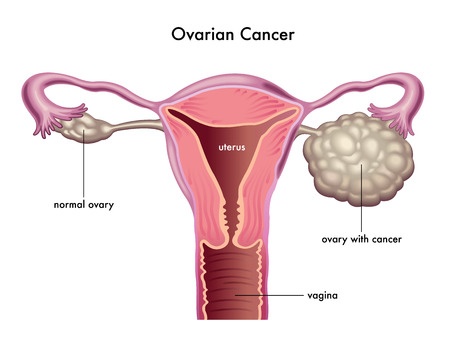Overview
Ovarian cancer is a type of cancer that grows in the ovaries, the two almond-sized organs responsible for the production of eggs and the hormones oestrogen, анд progesterone in women. The majority of these cancers (90%) develops in the outer lining of the ovary, the epithelium, and are thus named epithelial cancers. The less frequent types include the ones that arise from the egg cells and the ones that arise from their supporting cells.Although ovarian cancer is more common in post-menopausal women, it can develop at any age and its early detection is very difficult because of the very subtle symptoms, which can be mistaken for the symptoms of other diseases.
In most cases, doctors cannot identify the cause of ovarian cancer. Women with certain hereditary genetic mutations (such as in the BRCA1 and BRCA2 genes) will almost always develop this type of cancer. The role of hormone levels in ovarian cancer development is still controversial and much research is being carried to ascertain its exact influence.

Symptoms
Symptoms of ovarian cancers in its early stages are very slight and include:
- Frequent bloating
- Pain in the pelvis
- Pain in the lower stomach
- Back pain
- Feeling full quickly when eating
- Urinating more often than usual
- Pain during sexual intercourse
Risk factors
Certain factors make ovarian cancer more likely to develop, such as:- Having a family history of the disease, especially among the direct family members such as a mother, a sister or a daughter
- Having a family history of inherited nonpolyposis colorectal cancer
- Having certain inherited gene changes, namely mutations in the BRCA1 and BRCA2 genes
- Being post-menopausal
- Not having been pregnant
- Menstrual cycles that started before age 12 and went on after age 50

Other factors are known to reduce the risk of ovarian cancer:
- Having children and breast-feeding
- Having both tubes tied or a hysterectomy
- Taking oral contraceptives
Diagnosis
Diagnosis of ovarian cancer often begins with a routine physical examination, including a pelvic examination. The identification of any visible abnormalities will lead to the doctor ordering a few tests:- A blood test, for the detection of the CA-125, a cancerous marker that might indicate the presence of a cancerous growth in the body
- A transvaginal ultrasound, to evaluate the size and texture of the ovaries and the existence of any cysts
- A laparoscopy, i.e., a procedure where a tube with a camera is inserted in the pelvic cavity so that the doctor can get a detailed look at the ovaries. A small sample of ovarian tissue can be removed (biopsy) to be analyzed for the presence of cancer cells
- An aspiration of abdominal fluid, to look for cancer cells
- Imaging tests, such as CT scan or MRI, which will allow the doctor to get detailed information not only on the ovarian area, but also on the adjoining vagina and rectum.

Treatment
The course of treatment will depend on how aggressive and spread the cancer is.
- Surgery - In most cases, surgery will take place to remove all or most of the tumour mass. When the tumour is well-differentiated and confined to the ovary, surgical treatment might be the only necessary treatment.
- Chemotherapy - Chemotherapy can be used to target cells that the surgery did not or could not remove. Treatment can be carried out for 6 to 12 weeks, depending on the tumour and on the patient’s response to the chemotherapeutic agents.
- Radiotherapy - Radiotherapy is usually not recommended in patients with ovarian cancer, due to its low effectiveness in these cases. However, it can still be used in very specific circumstances.










